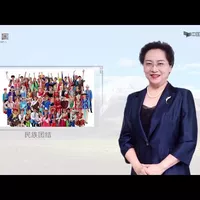1.2 人文 中国
1.2 Menschen in China
1.2 Humanistic China
1.2 Humanidades China
1.2 人文科学的な中国
1.2 Гуманитарные науки Китая
朋友 您好
Hello! Friends!
朋友 您好
欢迎 您 走进 中国
Welcome to the Overview of China
欢迎您 走进中国
了解 更 多 关于 中国 的 知识
and know more knowledge about China.
了解更多关于中国的知识
今天
Today
今天
我们 一 起来 学习 中国 的 行政区划
we are going to learn the administrative division
我们一起来学习中国的行政区划
人口 民族
population and ethnicity
人口民族
语言文字 和 宗教信仰
language and character, and religion of China.
语言文字和宗教信仰
中国 是 世界 四大 文明古国 之一
As one of the four ancient civilizations in the world
中国是世界四大文明古国之一
历史悠久 文化 灿烂
China is a nation with a long history and splendid culture.
历史悠久 文化灿烂
五千多年 以前
More than five thousand years ago
五千多年以前
中华文明 就 在 黄河流域
Die chinesische Zivilisation im Becken des Gelben Flusses
Chinese civilization appeared in the Yellow River Basin
中华文明就在黄河流域
和 长江流域 出现
and the Yangtze River Basin
和长江流域出现
形成 了 发达 的 农业 文明
Eine hochentwickelte landwirtschaftliche Zivilisation
formed a developed agricultural civilization.
形成了发达的农业文明
公元前 221年 秦始皇 统一 中国
In 221 BC, Emperor Qin Shihuang unified China.
公元前221年秦始皇统一中国
历经 汉唐
Through the development of Han, Tang
历经汉唐
宋元 明清 的 发展
Song, Yuan, Ming and Qing Dynasties
宋元 明清的发展
中国 版图 不断 发展 变化
the territory of China had been developing and changing.
中国版图不断发展变化
近代 以来
Since modern times
depuis les temps modernes
近代以来
面临 西方 列强 的 入侵
facing the invasion of western powers
面临西方列强的入侵
中华民族 不断 抗争
the Chinese nation had been fighting constantly
中华民族不断抗争
最终 建立 了 新 中国
and finally established the New China.
最终建立了新中国
中国 的 行政区划
The Administrative Divisions of China
中国的行政区划
中国 有 北京 上海 天津 和 重庆
In China, here are four municipalities directly under the Central Government
中国有4个直辖市
四 个 直辖市
Beijing, Shanghai, Tianjin and Chongqing
北京 上海 天津和重庆
有 五 个 自治区
five autonomous regions
有5个自治区
内蒙古 新疆 维吾尔族 宁夏回族 广西壮族 西藏
Inner Mongolia, Xinjiang Uygur, Ningxia Hui, Guangxi Zhuang and Tibet
内蒙古 新疆维吾尔族 宁夏回族 广西壮族 西藏
和 2个 特别 行政区
和2个特别行政区
香港 澳门
Hong Kong and Macao
香港 澳门
和 23个省
and 23 provinces
和23个省
河南 河北 山东 山西 安徽 陕西 等
Henan, Hebei, Shandong, Shanxi, Anhui and Shaanxi, etc.
河南 河北 山东 山西 安徽 陕西等
中国 的 人口 民族
Population and Ethnicity in China
中国的人口民族
中国 是 世界 上 人口 最多 的 国家
China is the most populous country in the world.
中国是世界上人口最多的国家
截至 2018年
Stand: 2018
By 2018
截至2018年
中国 人口 已 达到 14亿
Chinas Bevölkerung hat 1,4 Milliarden Menschen erreicht
China’s population had reached 1.4 billion.
中国人口已达到14亿
中国 人口 分布 不均
China's population is unevenly distributed
中国人口分布不均
呈现 东多 西少 的 特点
Der Osten ist mehr und der Westen ist weniger
showing the characteristics of more in the east and less in the west.
呈现东多西少的特点
如果 从 黑龙江省 的 漠河 到 云南省 的 腾冲 划 一条线
If we draw a line from Mohe of Heilongjiang to Tengchong of Yunnan
如果从黑龙江省的漠河到云南省的腾冲划一条线
东部 地区 集中 了 94%的 人口
94% of the population is concentrated in the eastern region
东部地区集中了94%的人口
人口 最 稠密 的 地方 是 台湾省
the most densely populated place is Taiwan Province
人口最稠密的地方是台湾省
人口 最 稀少 的 是 西藏自治区
while the most sparsely populated area is the Tibet Autonomous Region.
人口最稀少的是西藏自治区
中国 有 56个 民族
There are 56 ethnic groups in China
中国有56个民族
包括 汉族 壮族 蒙古族 回族 藏族
including Han, Zhuang, Mongolian, Hui, Tibetan
包括汉族 壮族 蒙古族 回族 藏族
维吾尔族 满族 苗族 彝族 朝鲜族 哈萨克族 傣族 等
Uygur, Manchu, Miao, Yi, Korean, Kazakh and Dai, etc.
维吾尔族 满族 苗族 彝族 朝鲜族 哈萨克族 傣族等
为了 实现 民族平等 和 民族团结
In order to achieve the goal of national equality and unity
为了实现民族平等和民族团结
自 1947年 以来
since 1947
自1947年以来
中国 先后 设立 了 五个 自治区
China has established five autonomous regions successively
中国先后设立了五个自治区
内蒙古 新疆 宁夏 广西 和 西藏
Inner Mongolia, Xinjiang, Ningxia, Guangxi and Tibet.
内蒙古 新疆 宁夏 广西和西藏
实行 民族区域 自治 是 中国 的 一项 基本 政治 制度
Regionale Autonomie für ethnische Gruppen ist ein grundlegendes politisches System in China
The implementation of regional ethnic autonomy is a basic political system.
实行民族区域自治是中国的一项基本政治制度
中国 的 语言文字
Sprache und Schrift in China
Language and Characters in China
中国的语言文字
汉语 是 世界 上 使用 人 数最多 的 语言
Chinese language is used by most population in the world
汉语是世界上使用人数最多的语言
也 是 在 中国 使用 最为 广泛 的 语言
and it is also the most widely used language in China.
也是在中国使用最为广泛的语言
汉语 还是 联合国 六大 工作 语言 之一
Chinese language is one of the six working languages of the United Nations
汉语还是联合国六大工作语言之一
普通话 是 通用 语言
Mandarin is the commonly used language
普通话是通用语言
此外 还有 七大 方言
moreover, there are seven major dialects
此外还有七大方言
主要 分布 在 南部 东南部
mainly distributed in the southern, southeastern
主要分布在南部 东南部
以及 北方 的 山西 一带
and Shanxi in the North.
以及北方的山西一带
除了 汉语 以外
Except Chinese Mandarin
除了汉语以外
还有 一些 少数民族 语言
there are also some minority languages
还有一些少数民族语言
例如 蒙古语 藏语 壮语 维吾尔语 朝鲜语 等
such as Mongolian, Tibetan, Zhuang, Uygur and Korean and so on.
例如蒙古语 藏语 壮语 维吾尔语 朝鲜语等
汉字 是 世界 上 最 古老 的 文字 之一
Chinese writing is one of the oldest characters in the world
汉字是世界上最古老的文字之一
是 音形 意 结合 一体 的 文字
which is a combination of sound, form and meaning
是音形意结合一体的文字
作为 文化 传承 的 载体
as a carrier of cultural heritage
作为文化传承的载体
蕴含着 独特 的 中国 哲理 和 中国 智慧
it contains unique Chinese philosophy and wisdom.
蕴含着独特的中国哲理和中国智慧
最 古老 的 汉字 是 甲骨文
The oldest Chinese characters are Oracle Bone Inscriptions
最古老的汉字是甲骨文
现代 汉字 有 简体字 和 繁体字
modern Chinese characters include simplified and traditional characters.
现代汉字有简体字和繁体字
简体字 是 现代 中文 的 一种 标准化 写法
Simplified character is a standardized form of modern Chinese.
简体字是现代中文的一种标准化写法
繁体字 主要 在 中国台湾 香港 和 澳门地区 使用
Traditional characters are mainly used in Taiwan, Hong Kong and Macao of China.
繁体字主要在中国台湾 香港和澳门地区使用
中国 的 宗教信仰
Religions in China
中国的宗教信仰
中国 有着 多种 宗教
There are many religions in China
中国有着多种宗教
主要 是 佛教 道教 伊斯兰教
Buddhism, Taoism, Islam
主要是佛教 道教 伊斯兰教
天主教 和 基督教
Catholicism and Christianity are mainly of them.
天主教和基督教
多种 宗教 共同 存在
Various religions co-exist
多种宗教共同存在
互相 影响 各自 发展
influence each other and develop independently
互相影响 各自发展
每 一种 宗教 都 与 中国 文化 相 融合
Jede Religion ist in die chinesische Kultur integriert
every religion is integrated with Chinese culture
每一种宗教都与中国文化相融合
呈现出 中国 特色
and presents Chinese characteristics.
呈现出中国特色
另外
In addition
另外
中国 还有 丰富 的 民间 信仰
there are also many folk beliefs in China
中国还有丰富的民间信仰
如 财神爷 土地爷
such as God of Wealth, God of Land
如财神爷 土地爷
灶神 山神 河神 等
God of Kitchen, God of Mountain, God of River and so on.
灶神 山神 河神等
这些 民间 信仰 有些 来自 自然 崇拜
Some of these folk beliefs come from nature worship
这些民间信仰有些来自自然崇拜
有些 源于 历史 人物
some from historical figures
有些源于历史人物
如 关公 门神 妈祖 等
such as Guan Gong, door god, Mazu, etc.
如关公 门神 妈祖等
此外
In addition
此外
中国 人 非常重视 祖先崇拜
Chinese people attach great importance to ancestor worship
中国人非常重视祖先崇拜
各地 建有 祠堂 用来 祭祀 祖先
ancestral temples have been built everywhere to worship our ancestors.
各地建有祠堂 用来祭祀祖先
中国 公民 有 宗教信仰 自由
Chinese citizens have the right of belief religious freely
中国公民有宗教信仰自由
受 宪法 和 法律 保护
it is protected by the Constitution and the law.
受宪法和法律保护
不过 值得注意 的 是
However, it is noteworthy that
不过值得注意的是
法律 规定
the law stipulates that
法律规定
信教 公民 的 集体 宗教 活动 一般 应当 在 已经 登记 的 宗教 场所 内 进行
communal religious activities should be carried out in registered religious sites
信教公民的集体宗教活动一般应当在已经登记的宗教场所内进行
任何 组织 和 个人
any organization or individual
任何组织和个人
不得 在 宗教 活动场所 以外 进行 传教 活动
couldn’t conduct missionary activities outside religious sites.
不得在宗教活动场所以外进行传教活动
好 今天 的 人文 中国 之旅 就 到 这里
So, das war's für heute mit der Tour durch China
好 今天的人文中国之旅就到这里
让 我们 稍作 休息
Lass uns eine Pause einlegen
Let's have a break
让我们稍作休息
接着 开启 新 的 旅程 吧
Beginnen wir eine neue Reise
and start a new journey in the following.
接着开启新的旅程吧

